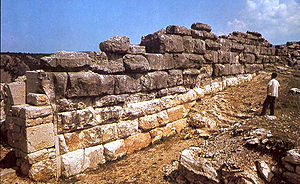Daorson
This article may require copy editing for grammar, style, cohesion, tone, or spelling. (August 2009) |

Daorson (Ancient Greek; Δαορσών) was the capital of a Hellenised[1][2][3][4] Illyrian tribe called the Daorsi (Ancient Greek Δαόριζοι, Δαούρσιοι; Latin Daorsei), who lived in the valley of the Neretva River between 300 BC and 50 BC. The remnants of this town, once the strongest settlement in the surrounding area, can be found at Ošanići, near Stolac, Bosnia and Herzegovina.[5]
History

Daorson consisted of three ensembles, the central one being the fort/acropolis, surrounded by the “cyclopean” walls made of huge[6] stone blocks (similar to those in Mycenae, in Greece).[5] All the important administrative, public and religious buildings were situated in it. The defensive wall extending from southwest to northeast was 65 metres long, 4,2 metres wide, and from 4,5 to 7,5 metres high; it had doors and towers on both sides.[5] The Daorsi adopted the Greek language and alphabet; they kept trading relations with the Greeks.[5] The remnants of numerous wine amphorae have been found, including some ceramic fragments. The most valuable of the finds is a bronze helmet decorated with a series of Greek mythological figures, including Aphrodite, Nika, Heli, Dionysius, Muse, Pegasus, and others. The inscription on it is similar to the inscription on a helmet found in Macedonia.[5] The remnants of a granite sculpture of Cadmus and Harmonia have also been found; the piece includes an Illyrian relief with thirteen snakes and five pairs of eagle’s wings.[5] In a small building a mint facility was uncovered, with appropriate tools and stencils, 39 different coins (29 bearing the image of King Ballaios from 168 BC, and 9 with a Greek inscription and a boat image).[5] Money was of immense importance to the Daorsi, ensuring the tribe's independence while also confirming their well developed business, cultural and trade links with other peoples.[5][7]
The Daorsi were attacked by the Delmatae[8] and consequently joined Issa[9] in seeking the protection of the Roman state. The Daorsi, abandoning Caravantius, fought on the side of the Romans and provided them with their strong navy. After the Illyrian Wars the Romans gave the Daorsi immunity.
References
- ^ The Art treasures of Bosnia and Herzegovina by Đuro Basler, Mirza Filipović, Sulejman Balić,1987,page 28,"Only to the south of there, in the River Neretva basin, had the influence of Hellenism taken root, principally among the Illyrian Daorsi who occupied"
- ^ Grčki utjecaj na istočnoj obali Jadrana: zbornik radova sa znanstvenog skupa održanog 24. do 26. rujna 1998. godine u Splitu by Nenad Cambi,ISBN-9531631549,2002,page 432,"and the 3rd century BC when some of the indiginous tribes were fully hellenized"
- ^ Institute of Archaeology bulletin by University of London. Institute of Archaeology - 1978,page 21
- ^ Dalmatia: research in the Roman province 1970-2001 : papers in honour of J.J by David Davison, Vincent L. Gaffney, J. J. Wilkes, Emilio Marin,2006,page 21,"completely Hellenised town"
- ^ a b c d e f g h http://www.coe.int/t/dg4/cultureheritage/regional/see/IRPPSAAH/PTA%20Ljubljana/BH_22-PTA-APPROVED_web.pdf
- ^ Urbano biće Bosne i Hercegovine - page 27 by Seka Brkljača - 1996, "Its name was Daorson. It belonged to the Hellenistic civilization and sphere of the Greek culture. Its 46 meters of the old fortress are preserved"
- ^ [1] Wilkes, J. J. The Illyrians, 1992,ISBN 0631198075,page 177,"... Two other coinages of Illyrian peoples are dated to the period following 168B(:. Those with the legend DAORSON with a galley on the reverse were produced by the Daorsi. ..."
- ^ I greci in Adriatico, Volume 2 by Lorenzo Braccesi, Mario Luni, page 152, "The Daorsi suffered directly from the attacks of the Delmatae and were understandably one of the first peoples who had left Genthius half brother Caravantius and sought protection from the Roman state placing their armed forces at the disposal of the Romans. After the war they were rewarded by having been given immunity..."
- ^ The magistrates of the Roman Republic - by Thomas Robert Shannon Broughton - 1960 - page 446, "Head of a commission sent, after the receipt of complaints from Issa and the Daorsi, to observe conditions in Illyria and Dalmatia"
See also
Bibliography
- Wilkes, J. J. The Illyrians, 1992,ISBN 0631198075,
External links
